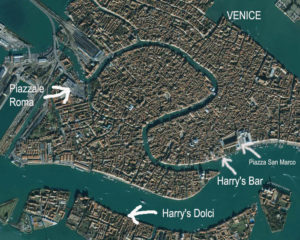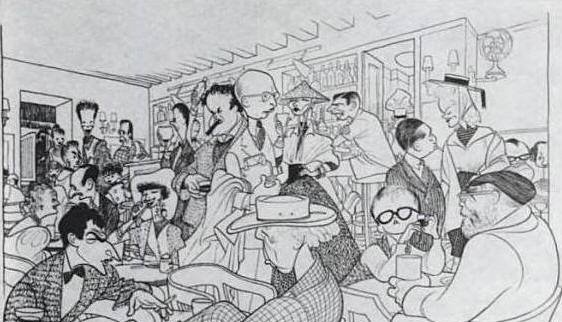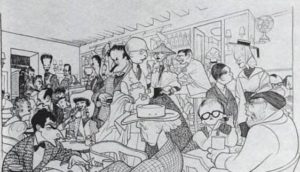
Arriving in Venice
I drove across the laguna on the Ponte della Libertà and into the Garage Communale around 2:00 a.m. At the barricaded entrance, the attendant in the booth spoke over the intercom.
“How long will you be here?”
“Five days.”
“Go up to the top level.”
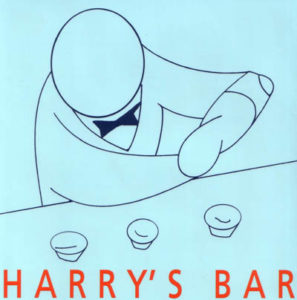
After parking my car on the top level and unloading my luggage, I walked across the deserted Piazzale Roma hoping that there would still be some means of water transportation to San Marco at this hour. No vaporetti or water taxis were in sight so I called my hotel to send a water taxi over. Ten minutes later, my taxi arrived. The driver slowly wove through the Rio Nuovo canal. On that surreal ride on a crisp early May night, the only sounds were of the boat’s engine, its wake, and the water’s light tapping against the walls of the dark buildings and empty boats docked along the canal. After turning onto the Rio San Margherita, the boat soon arrived at the Canale della Guidecca. A few distant boats could be heard as we passed the Chiesa di San Eutemia and Chiesa del Redentore on the right. The dome of the Chiesa della Salute soon appeared as we curved to the left. As we crossed the Bacino di San Marco, the details of the bell tower of San Marco and the Palazzo Ducale became clearer. The driver then steered the boat into the small cul-de-sac canal of Rio dei Giardinetti and proceeded up to the dock of the Luna Hotel Baglioni. I unloaded my bags, paid the driver, checked in, and went up to my cozy, but plush, single room.
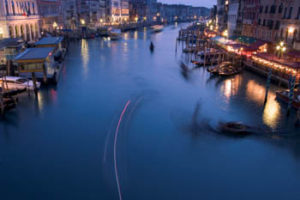 I easily could have plopped on the bed and have been in an immediate slumber, but my curiosity made me do one more thing before going to bed. I had to see this culinary landmark, if only the outside of it for now. I knew that I was very close to Harry’s Bar, but in the rush of researching and traveling up to Venice from Florence, I did not have time to focus on getting my bearings on the precise location of it in relation to walking from the Baglioni. I went downstairs to the reception desk.
I easily could have plopped on the bed and have been in an immediate slumber, but my curiosity made me do one more thing before going to bed. I had to see this culinary landmark, if only the outside of it for now. I knew that I was very close to Harry’s Bar, but in the rush of researching and traveling up to Venice from Florence, I did not have time to focus on getting my bearings on the precise location of it in relation to walking from the Baglioni. I went downstairs to the reception desk.
“Can you tell me where Harry’s Bar is?” I asked the night desk clerk.
“It’s closed now, Signore.”
“I know, but I’m going there tomorrow and I’d just like to know where it is.”
“You go out those doors and turn left towards the Grand Canal. It’s about fifty meters.”
“Do you mind unlocking the door? I’d just like to run down there quickly.”
“Sure.”
The doors were on the opposite side of the lobby from where the boat dock was located. These doors were right on Calle Vallaresso, the street address of Harry’s. I walked down the vacant narrow street and as the San Marco vaporetto dock came into view, I arrived at the boarded up door and window of Harry’s on my left. The fun would start tomorrow. Off to bed.
The Origin of Harry’s Bar
On May 13, 2006, Harry’s Bar in Venice reached an important milestone: its 75th anniversary. When Giuseppe Cipriani opened the bar in 1931, it was just a simple bar that served a handful of cocktails and light snacks. It was successful from the day it opened. Within a few years it expanded into a full service restaurant. In its illustrious history, Harry’s Bar has made several contributions to the restaurant world from its culinary and beverage inventions to setting a standard for friendly first class service and colorful atmosphere.
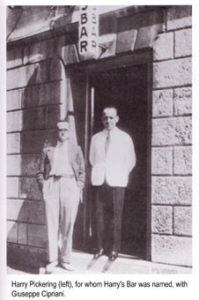 The story of Harry’s Bar began two years before it opened. Giuseppe had been a bartender in Venice at a few of the luxury hotels. For a time, he thought about opening his own bar which would offer the same quality and service of a hotel bar minus the clients’ difficulty in having to walk through noisy lobbies or maneuvering around luggage and hotel staff.
The story of Harry’s Bar began two years before it opened. Giuseppe had been a bartender in Venice at a few of the luxury hotels. For a time, he thought about opening his own bar which would offer the same quality and service of a hotel bar minus the clients’ difficulty in having to walk through noisy lobbies or maneuvering around luggage and hotel staff.
One regular customer to the Hotel Europa bar, where Giuseppe worked, was a young American named Harry Pickering. He was not happy with his particular living situation in Venice. Visits to the hotel bar helped him pass the time. Eventually his money ran out and he told Giuseppe that he did not have enough money to return to America. Giuseppe lent him $5,000. Two years later, Harry returned to pay back the loan. To show his appreciation, Harry gave Giuseppe an additional $20,000. Harry told him that he should now open his own bar and that he should call it Harry’s Bar.
A few days later, Giuseppe’s wife, Giulietta, found the location for the bar which was a vacated cordage warehouse at the end of Calle Vallaresso. Simple elegance was the effect that Giuseppe wanted to convey to his customers so that they would not feel oppressed by the décor. He also wanted just the right amount of lighting that would promote a comfortable surrounding for casual conversation.
Arriving at Harry’s Bar
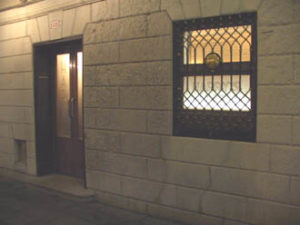 Two weeks before my arrival in Venice, I emailed Harry’s Bar to express my interest in writing an article about the restaurant. To my surprise, the response was from the man himself, Arrigo Cipriani, Giuseppe’s son, who continued what his father started without missing a step and took the Cipriani operation to the next level by maintaining the bar’s highly respected reputation and by expanding the Cipriani organization beyond Venice.
Two weeks before my arrival in Venice, I emailed Harry’s Bar to express my interest in writing an article about the restaurant. To my surprise, the response was from the man himself, Arrigo Cipriani, Giuseppe’s son, who continued what his father started without missing a step and took the Cipriani operation to the next level by maintaining the bar’s highly respected reputation and by expanding the Cipriani organization beyond Venice.
The next day I woke up late but with plenty of time to get ready for having lunch at Harry’s. The dress code of this restaurant today runs the gamut from touristy casual to elegant suits and dresses, although, men wearing any bottoms with lengths shorter than a bad case of high waters politely will be turned away. I decided that I would arrive wearing a suit and tie out of respect to this monument of hospitality. Just before 1:00 p.m., I walked out onto the street which was bustling with locals and tourists walking in both directions. Harry’s was no longer boarded up and for the first time I saw the famous doors and windows that welcomed each patron.
I walked inside and my reaction was perhaps typical of many of first time visitors: It’s so small. But I was not complaining. As I later learned, its intimacy is part of its charm. Entering inside is definitely not the experience you’d have at many other restaurants where you enter and are able to peek into the main room without creating much attention. The bar is right on the left and as soon as you are in front of the bar, you are swallowed up into the world of Cipriani. I was immediately greeted with a smile and hello from the maitre d’, the bartenders, and waiters. As Otello, the maitre d’ on duty, took me to my table, I gave him my card and asked him to give it to Mr. Cipriani. “Certainly, Signore.”
I was seated against the wall opposite the bar about midway into the room. My waiter came to the table. I was tucked in tightly. I was sandwiched between my chair that was touching the wall and the table that had me pinned to my seat. I would not be able to stand up from the table without the help of the staff. A nice couple from England at the table on my left were no further than two feet from me. The lady, in fact, was right next to me and we occasionally gently elbowed each other. The occasional “sorry” and “excuse me” led the three of us having nice conversation throughout lunch.
My waiter came to my table with one of Harry’s Tiffany-green menus. “Here is your menu, sir. Would you like a cocktail?”
“Yes, a Bellini, please.”
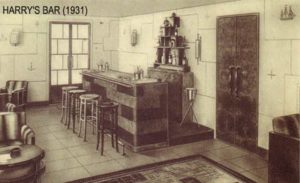
The Bellini and Other Cocktails
The Bellini
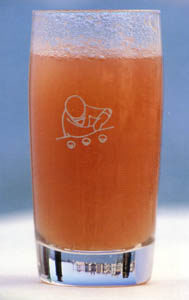 Giuseppe Cipriani created this cocktail early in Harry’s Bar’s history. He gave it its name in 1948, inspired by the fifteenth-century Venetian painter Giovanni Bellini because he admired the pink glow in one of Bellini’s paintings. One of his favorite fruits was the white peach, which he liked so much that he put much thought into how he could transform its flavor into a cocktail for Harry’s Bar. He found what he was looking for from his experiments of mixing white peach puree with the Veneto’s Prosecco sparking wine. It received rave reviews when he introduced it to his customers. Perhaps the blend worked so well because of the peachy tones in the Prosecco wines.
Giuseppe Cipriani created this cocktail early in Harry’s Bar’s history. He gave it its name in 1948, inspired by the fifteenth-century Venetian painter Giovanni Bellini because he admired the pink glow in one of Bellini’s paintings. One of his favorite fruits was the white peach, which he liked so much that he put much thought into how he could transform its flavor into a cocktail for Harry’s Bar. He found what he was looking for from his experiments of mixing white peach puree with the Veneto’s Prosecco sparking wine. It received rave reviews when he introduced it to his customers. Perhaps the blend worked so well because of the peachy tones in the Prosecco wines.
Other signature cocktails are:
The Negroni
A mix of gin, Campari, and sweet vermouth with a hint of fresh orange. The traditional story is that it was invented in the early 1920s and named after Florentine Count Camillo Negroni. It was invented at the Casoni Bar in Florence when he asked his favorite bartender, Fosco Scarselli, to add gin to an Americano (Campari with sweet vermouth). It is a very popular cocktail at Harry’s.
The Montgomery
A gin and dry vermouth martini. A very strong variant of the classic martini. It is made by mixing fifteen parts dry gin with one part extra dry vermouth, and shaking with ice. It is named after the odds that Field Marshal Bernard Montgomery supposedly preferred on the battlefield: fifteen of his men to every one of the enemy. Ernest Hemingway is said to have named this cocktail when it was first served to him at Harry’s.
The Roger
Vodka or rum with peach and orange juice. Created in Harry’s Bar several years ago and named after one of Harry’s most famous bartenders.
Thursday Lunch
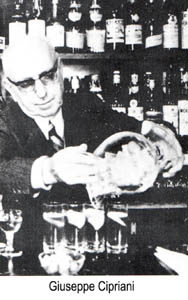 The waiter came back with my Bellini.
The waiter came back with my Bellini.
“Here you are, sir. Are you ready to order?”
“Yes. Excuse me, what is your name?”
“Paul.”
“Paul, let me explain. I’m here for five days and I plan to have all my meals here at Harry’s so I would like to sample as much of the menu as possible.”
“Ah, very good. We look forward to having you. I’ll let the other waiters know.”
“I’ll start with the pasta fagioli, then the beef carpaccio, and then the curry scampi with rice pilaf. I’ll also have a bottle of the 2003 Blanc des
Rosis [a white blend of Tocai Friulano, Pinot Grigio, Sauvignon Blanc, Malvasia and Ribolla Gialla from the Schiopetto winery in the Friuli-Venezia Giulia region].”
Between the soup and carpaccio courses, Arrigo entered the room from the kitchen wearing his trademark dark double-breasted suit and a red tie. He went about his routine of stopping at several of the tables to say hello to his guests before coming to my table. The English couple were vaguely familiar with who he was but took note of the formality of meeting as he greeted me.
“Hello. I’m Arrigo Cipriani. It’s good to have you here.”
“How do you do Signor Cipriani? Thank you for having me.” I was so pinned to my seat that there was no way I was able to stand up.
“May I sit down?”
“Yes, of course.”
“Everything is okay?”
“Yes, it’s all wonderful.”
“We should have dinner together tonight so we can talk, no?”
“I’d be honored.”
I continued with my lunch. Dessert was what I was particularly looking forward to. The vanilla meringue cake. But I also wanted to try the lemon meringue cake. Paul said I should try both. Perfect!
Arrigo Cipriani
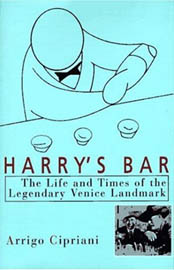 Arrigo was born a year after Harry’s was opened. Giuseppe named him after the bar – Arrigo being the Italian version of Harry. While he saw much of his father at work running a bar, his first attempt at a career was as lawyer. He got through law school but when he sat for his first law license exam, he barely passed. At that point, his father put him to work at Harry’s believing that his son would not turn out to be a good lawyer. Arrigo didn’t seem to mind since he didn’t have much of a desire to be in the legal profession. He did, in fact, take to working at Harry’s. By the late 1950s, he assumed his father’s role as manager of the bar.
Arrigo was born a year after Harry’s was opened. Giuseppe named him after the bar – Arrigo being the Italian version of Harry. While he saw much of his father at work running a bar, his first attempt at a career was as lawyer. He got through law school but when he sat for his first law license exam, he barely passed. At that point, his father put him to work at Harry’s believing that his son would not turn out to be a good lawyer. Arrigo didn’t seem to mind since he didn’t have much of a desire to be in the legal profession. He did, in fact, take to working at Harry’s. By the late 1950s, he assumed his father’s role as manager of the bar.
As the heir apparent, Arrigo emphasized the three founding principles of Harry’s Bar: providing quality food with exceptional service and with a simple elegance. The food that Harry’s Bar has offered all these years is the “home cooking of the Italian kitchen of the old days, a taste that is universal to everyone, regardless of nationality. It is the only cuisine that can be prepared and repeated daily. This is one of the reasons of our success.”
The Ciprianis also believe that in addition to an accessible menu, their long term success is due to their attention to the details necessary in providing a level of service unsurpassed by any other hospitality organization. The Ciprianis know that the customer always needs to feel at home. Arrigo explains, “We wish to serve our clients as we would like to be served ourselves, with the greatest care and attention because serving is above all, loving.”
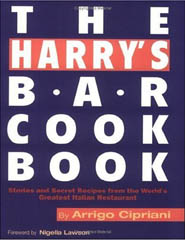 Finally, a decor of simple elegance has always been the theme so that customers feel that they are dining in a smart and polished restaurant, yet not turned off or overwhelmed with a stuffy or snobbish perception. The lone diner can especially expect a welcoming reception. No matter how busy the restaurant is, the staff will somehow find a table for someone eating alone. “My father told me that we always have room for a person arriving by himself,” Arrigo said. “One time – it was the first week in September which is always a busy time for us – someone came in alone, and the only table available was a table for eight. So my father gave him that table.”
Finally, a decor of simple elegance has always been the theme so that customers feel that they are dining in a smart and polished restaurant, yet not turned off or overwhelmed with a stuffy or snobbish perception. The lone diner can especially expect a welcoming reception. No matter how busy the restaurant is, the staff will somehow find a table for someone eating alone. “My father told me that we always have room for a person arriving by himself,” Arrigo said. “One time – it was the first week in September which is always a busy time for us – someone came in alone, and the only table available was a table for eight. So my father gave him that table.”
One can understand Arrigo’s skills as a host and effective communicator as soon as he walks up to their table and greets them, a ritual he regularly does. He has also expressed his thoughts and views in print books such as Harry’s Bar: The Life and Times of the Legendary Venice Landmark and The Harry’s Bar Cookbook. He is also the author of two novels, Heloise and Bellinis (available in English) and Anch’io Io Ti Amo (I Love You Too).
My Dinner with Arrigo
I returned for dinner at 9:00 p.m. Arrigo greeted me and we sat at the same table where I had lunch. Once again I was pinned to my seat. The waiter immediately came to our table.
 “A cocktail?” asked the waiter.
“A cocktail?” asked the waiter.
“What would you like, Joe? How about a martini?” suggested Arrigo.
“That sounds good.”
“When you arrived this afternoon, I did not tell the staff that you were coming. How was your lunch?”
“Very good. Loved the carpaccio. Your staff took good care of me.”
“So, Joe. Tell me your story.”
Well I did my best so that he would not regret having asked that question. I kept the facts about my background and my work concise. But I understood that part of my answer needed to be helpful to him understanding why I was there at his restaurant. I wanted him to understand that I was not there to write a critical review. I told him that I became a fan of his before I got halfway through his autobiography as well as when I saw a photo of the vanilla meringue cake in his cookbook. The evening was just a normal conversation between a couple of guys telling stories.
The waiter returned to take our cocktails.
“Joe, what would you like?”
“Mr. Cipriani, I’ll just let you and your staff take care of me.”
Arrigo smiled. “Very good. Call me Arrigo, by the way. Let’s start with baby shrimps with olive oil. Then the tagliolini gratinati al prosciutto and then the liver with onions. And, Joe, how about a bottle of Tignanello?”
“If we must.”
“At which hotel are you staying?”
“Right here at the Baglioni.”
“Very nice.”
“Well, I wanted to stay close by because I knew I’d be drinking and I didn’t want to be driving around Venice.”
Arrigo responsive expression said, “Not bad,” acknowledging my feeble attempt at comedy.
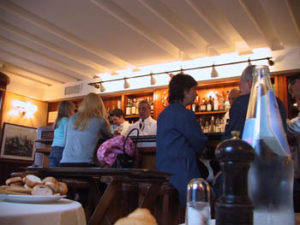 While we ate the baby shrimps, three people, a couple and a lady, entered and were seated immediately to one of the corner tables. They said hello to Arrigo as they walked by. Arrigo laughed. “The lady by herself is the daughter-in-law of [a very famous deceased millionaire].”
While we ate the baby shrimps, three people, a couple and a lady, entered and were seated immediately to one of the corner tables. They said hello to Arrigo as they walked by. Arrigo laughed. “The lady by herself is the daughter-in-law of [a very famous deceased millionaire].”
“Where’s her husband?”
Arrigo laughed. “I’m not sure. We’re probably better off not knowing. These shrimps were swimming this morning.”
“Fresh indeed.”
“How do you like having dinner down here in the bar?” – [as opposed to the upstairs dining room]
“It’s very entertaining. Like theater.”
“Quite an atmosphere, huh?”
“Yes it is. Arrigo, what you have done here at Harry’s is really something special.”
“I didn’t do anything. This is all my father’s work.”
“I understand, but you’ve kept it going for a long time and expanded it.”
During the pasta course, we talked a little about the method that has distinguished Harry’s Bar throughout its history, its exceptional service.
“I admire the philosophy of Harry’s Bar. Quality food, service and simple elegance. It’s a wonder to me that so many restaurants in the world don’t understand the importance of service. Harry’s is a testament to the success of that philosophy since you’ve been opened so long.”
“It’s something that is not so obvious to others. My father and I believe that service makes the experience more personal. For instance, mini-bars in hotel rooms disturb me.”
“Why?”
“Because there’s no personal service involved.”
While we ate the liver with onions, we talked about some of the celebrity patrons of Harry’s. “You are known to treat all your guests as if they were celebrities.”
“We want to take care of everyone we serve.”
“Has Clooney eaten here?”
“Rosemary or George?”
“George.”
“I saw him last year. He invited me to visit him at his villa on Lake Como.”
“You should do that. In fact, I could be available to come get you and we could go see George together. Yeah! Imagine the trouble the three of us could get into. Forget about it.”
“You know I also recently met – what’s his name – Puffy? No, Puffy Dad?
“No, Puff Daddy. Then he became P Diddy. Now he’s just Diddy.”
“Him. He’s a nice young man. We had a big party in New York and I was dancing to rap music.”
“Speaking of celebrities, Arrigo, have you met or heard of any of the Indian actresses in the Bollywood movies?”
“No.”
“There’s one in particular you need to know about. Her name is Aishwarya Rai.”
“Who’s she?”
“She’s the most famous Bollywood actress and probably the most popular celebrity in India. One of the biggest celebrities in all of Asia.”
“Why must I know about her?”
“So that you don’t have a heart attack when she walks through that door. She’s a stunning beauty. She is just now slowly becoming a star in the western world. She’s still relatively unknown in both Italy and the U.S.”
“Really?”
“She’s a throwback to the days of the elegance, grace and poise of Audrey, Ingrid, Jackie, and Grace. Give me a day or so to put some information together for you.”
It was time for dessert.
“Joe, how about a gelato? Cioccolato?”
“Please.”
“And how about cream crepes with vanilla gelato?”
“Why not?”
The chocolate gelato was lethal. Arrigo told me his recipe. “It’s very simple. One liter of milk. One liter of chocolate. Thirty-six eggs. I’ll tell you something funny about my crepes. One critic told me that the Grand Marnier I use for my crepes was amazing. I just said thank you. I didn’t have the heart to tell him that I simply use triple sec.”
“Arrigo, next week will be the 75th anniversary of Harry’s Bar. Will you have a big party here to celebrate?”
“No.”
“Why not?”
“It would be impossible to have a party. Everyone would want to come. We couldn’t fit everyone in here. We’ll celebrate quietly.”
Friday Lunch
I returned at 1:00 p.m. Nevio, the maitre d’, greeted me.
“Mr. Cipriani suggested that you eat upstairs so that you can experience the upstairs dining room.”
“Great!”
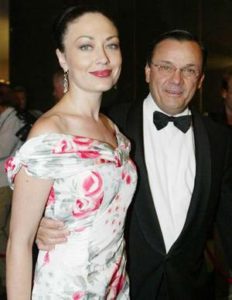 The upstairs is about the same dimensions of the bar downstairs, but a bit more spacious. The round tables are a little larger and taller than the ones downstairs. There is also a bit more space between the tables. My waiter, Giuseppe, took go care of me. “A Manhattan, please.” For lunch, I had a baccalà sandwich, risotto e bisi (peas), and filet of sole with baby artichokes. I ordered a bottle of the Maculan Winery’s 2004 Breganze di Breganze, a blend of Tocai and Sauvignon Blanc from the Veneto region. For dessert, I had the zabaglione cake.
The upstairs is about the same dimensions of the bar downstairs, but a bit more spacious. The round tables are a little larger and taller than the ones downstairs. There is also a bit more space between the tables. My waiter, Giuseppe, took go care of me. “A Manhattan, please.” For lunch, I had a baccalà sandwich, risotto e bisi (peas), and filet of sole with baby artichokes. I ordered a bottle of the Maculan Winery’s 2004 Breganze di Breganze, a blend of Tocai and Sauvignon Blanc from the Veneto region. For dessert, I had the zabaglione cake.
As my appetizer arrived, so did an Australian couple at the table between me and the window looking out over the canal. They turned out to be former mayor of Sydney, the Honorable Frank Sartor, and his beautiful wife, Monique Flannery, who reminded me of Lesley-Anne Down.
“Am I blocking your view?” The mayor politely asked me.
“No, no. Not entirely. You’re fine, thank you.”
“I think that your view has improved since my husband is sitting there,” Monique pointed out.
“I might say something like that if you were sitting there instead of him,” I explained.
They were fun. Great conversation about eating at Harry’s, eating in Venice, our Italian connections, Australia, Australian wine, and the 2000 Sydney Summer Olympics which took place while he was in office.
Friday Dinner
Harry’s was packed at nine o’clock. But the staff – my new buddies – all said hello and took care of me. My table against the wall was set and waiting for me. I started out with a negroni. Andrea was my waiter. Both Nevio and Otello were overseeing the dining rooms. I had artichoke soup and sautéed calf’s kidneys. A bottle of Donnafugata Mille e Una Notte, a Nero d’Avola varietal. Vanilla gelato for dessert. Just a light dinner. I had to pace myself.
Carpaccio
Today, there are many forms of carpaccio that can be found on the menus of many of the finer restaurants around the world. It has become a generic term for any form of thinly sliced meat or fish with a variety of different condiments. Yet, the progeny of all carpaccios leads back to its creation at Harry’s Bar.
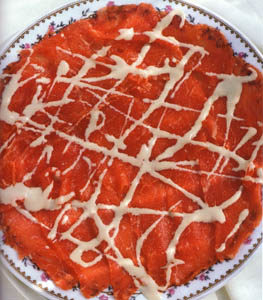 In 1950, there was an exhibition dedicated to the Renaissance painter, Vittore Carpaccio. It was one of the most important art events in the international art world as well as the most important event taking place and topic of discussion in Venice. Giuseppe especially admired a series of Carpaccio paintings that were predominantly red and white. On one fateful day that year, an Italian contessa, who was a regular patron, walked into Harry’s feeling very sad. When Giuseppe asked her what was wrong, she explained that her doctor put her on a strict diet and forbid her from eating cooked meat. Giuseppe said, “Give me fifteen minutes.” He later returned with a plate of thinly-sliced beef with a mayonnaise sauce. She loved it. When she asked what the dish was called, he promptly responded, “Carpaccio!” As if it was an entrée that he’d been serving for years. The dish reminded him of the artist’s red and white paintings. To this day, beef carpaccio remains the most popular item on the menu.
In 1950, there was an exhibition dedicated to the Renaissance painter, Vittore Carpaccio. It was one of the most important art events in the international art world as well as the most important event taking place and topic of discussion in Venice. Giuseppe especially admired a series of Carpaccio paintings that were predominantly red and white. On one fateful day that year, an Italian contessa, who was a regular patron, walked into Harry’s feeling very sad. When Giuseppe asked her what was wrong, she explained that her doctor put her on a strict diet and forbid her from eating cooked meat. Giuseppe said, “Give me fifteen minutes.” He later returned with a plate of thinly-sliced beef with a mayonnaise sauce. She loved it. When she asked what the dish was called, he promptly responded, “Carpaccio!” As if it was an entrée that he’d been serving for years. The dish reminded him of the artist’s red and white paintings. To this day, beef carpaccio remains the most popular item on the menu.
I like to speculate on what went through Giuseppe’s mind when he went into the kitchen. Imagine those precious fifteen minutes in which he had to figure out what to bring out to the contessa. In how many different directions can anybody’s imagination and thought process go to solve this problem within a short period of time? My guess is not many. I believe that this was an example of Italian logic at its most efficient. I think that Giuseppe thought, “Hmm. She cannot eat cooked beef. No problem. I’ll make her Uncooked beef.” Problem solved, not to mention profitable and historical new menu item invented.
Saturday Lunch
I arrived at my usual time. Roberto was my waiter. This time I met a third maitre d’, Marco, who normally manages one of Harry’s sister restaurants, Cipriani London. He was in for a short trip to the home office. For my cocktail, I returned to a Bellini. Marinated salmon to start followed by scampi risotto. Just a plate of fruit for dessert. No wine, just water. I had some traveling to do right after lunch so that I could return in time for dinner.
Before I left, I asked Marco if I needed to arrive earlier than nine o’clock for dinner since the restaurant was likely to be very busy that night.
“You come when you want.”
“Okay. Nine o’clock then?”
“No problem.”
I left Harry’s and took a vaporetto back to the Piazzale Roma to get my car and drive back across the laguna to Mestre where there was a Blockbuster Video store. Following up on our conversation two nights before, I wanted to find a DVD of one of Aishwarya Rai’s movies to give to Arrigo.
“Do have a copy of the DVD Bride and Prejudice for sale?”
“Not a new one. We have a used one.”
“That will do.”
This was Aishwarya Rai’s first western movie and I thought it would be a good introduction to Arrigo. There was a nearby Internet café so I searched for a photo of Ms. Rai that caught an expression that I thought she might convey on arriving at Harry’s Bar and meeting the famous Signor Cipriani: a look of the pleasure of meeting him. Respect for who he is and where she is dining. And ready to have some fun.
Saturday Dinner
I was worn out after I returned to my hotel from my field trip to Mestre so I napped for a few hours. By the time I woke up, I had just a few minutes to get ready for dinner and wrap my gift to Arrigo.
I walked into Harry’s at 9:05 pm. All the waiters and bartenders in the room called out, “Joe! You’re late!” The head bartender, Claudio, turned and looked at the clock behind him, moved the minute hand back to twelve and said to me, “Now you’re on time.”
The room was even more crowded than the night before. People were all crowded around the bar and waiting for tables to open. I got nervous when I saw that no table was available. But as soon as I noticed this, Paul and Roberto walked in the room from the kitchen holding high in the air a small round table and chair, plopped them in the middle of the room and motioned me to come to the table. Once I sat down, Paul brought in a linen table cloth and set ups for me. The only thing missing was a young and overwhelmed Lorraine Brocco holding onto my arm. Although a lady sitting at the table next to me did asked, “Are you somebody famous?” I smiled and said, “Madam, please. You’re embarrassing me. You don’t recognize me?” I paused a moment and then winked at her. Marco was my waiter. Otello, Nevio, and Marco were all there. I started with a martini. When Arrigo walked into the room, I gave him the wrapped DVD. After visiting a few of the tables, he then disappeared from the room. He soon reappeared and came directly to my table wearing a controlled grin.
“What did you think of the photo?”
“She’s very beautiful. But she’s not my type.”
“Yeah, right. Not your type. Baloney.”
“No, no. I’ll watch the movie. Thank you for the gift.”
My dinner that night was scampi e fagioli, a repeat of the calf’s kidneys with a bottle of the Lungarotti Rubesco from Umbria. It was also a night of returning to a piece of the zabaglione cake.
Before Arrigo left the restaurant, he stopped by my table. “Perhaps tomorrow you might like to have lunch over on Giudecca at Harry’s Dolci. It’s outside and on the canal. Tomorrow should be nice. I’ll be there during lunch.”
“Excellent. I’ll do that.”
Celebrities, Aristocrats, Writers, and Artists
Harry’s Bar quickly developed a reputation as the place to go in Venice to have fun, especially after World War II. Such a reputation eventually attracted a distinguished list of clientele.
One of the most famous regulars was Ernest Hemingway who lived in Venice from 1948 to 1950. He even lived at the little inn, the locanda, that was owned by Giuseppe on the island of Torcello. He was working on his novel, Across the River and into the Trees which contained a scene set in Harry’s Bar.
Orson Welles and Truman Capote were two other regulars at Harry’s. Among other high profile clientele were Arturo Toscanini, Charlie Chaplin, Baron Phillipe de Rothschild, Aristotle Onassis, Henry Fonda, Barbara, Peggy Guggenheim, and Woody Allen.
In 1960, Queen Elizabeth II and Prince Phillip had lunch at the locanda during a visit to Venice.
Sunday Lunch at Harry’s Dolci
At a quarter to one, I was running too late to figure out which vaporetto to take to Giudecca so I asked the hotel concierge to call a water taxi for me. After a little confusion of negotiating between incoming taxis to the small canal, we made our way across the canal to Giudecca where the boat docked at the restaurant’s entrance. Claudio, one of the waiters, seated me outside on the terrace. Arrigo soon came out to say hello and offered me a negroni. Just as he walked up to me, an ocean liner and its guiding tug boats paced through the canal momentarily blocking out any view across the canal. “Joe, I’m sorry about the view.” A light lunch. For my antipasto I had seared tuna followed by homemade ravioli. A little house white wine. Zabaglione cake for dessert. Claudio afterwards allowed me to see the Dolci kitchen where all the Harry’s desserts are made.
What’s Cipriani and What’s Not
There’s much confusion about the ownership of various bars, restaurants, and other venues that have either the Harry’s or Cipriani name. For instance, many patrons have been to a Harry’s Bar, not realizing whether or not they are in a location owned by the Cipriani family.
What’s Cipriani:
Harry’s Bar in Venice. This is the original Harry’s Bar where it all started.
Harry’s Dolci in Venice. Opened in 1984 across the lagoon on the island of Giudecca.
Harry Cipriani in New York. Opened in 1985 on 59th Street and 5th Avenue. It is the flagship of the Cipriani properties in New York.
Downtown Cipriani is located at West Broadway near Broom Street in New York City. The more casual version of Harry Cipriani, Downtown offers a slightly less formal menu than its uptown predecessor.
The Rainbow Room and Rainbow Grill. In 1998, Rockefeller Center approached the Cipriani family to take over the operation of the Rainbow Room facilities, including the Rockefeller Center Club and banquet rooms.
Cipriani Le Specialità located in the business district of Manhattan opposite Grand Central Station, offers a fast service menu. It also offers catering menus and an inhouse specialty food store.
The Cipriani New York operations also include event halls on 23rd and 42nd Streets.
Cipriani London is located at 23-25 Davies Street. It just opened two years ago. In no time it became a happening place. In June when there on a Friday night, the place was packed. Rod Stewart and Chris Noth (Big from Sex in the City) showed up.
Cipriani Hong Kong, a private dinner club, was opened by Arrigo’s son, Giuseppe, in 2003.
Cipriani Porto Cervo is part of one of the most exclusive Mediterranean private summer clubs in the world, The Billionaire, which sits at the heart of the beautiful Costa Smeralda on the island of Sardegna.
Locanda Cipriani. A property that Giuseppe bought on the island of Torcello in the 1920s and later turned into a small inn. It is now owned and operated by Arrigo’s cousins.
What’s Not Cipriani:
(All of these locations listed below are high-end operations, however, they all lack the Cipriani trademark standard of service.)
Hotel Cipriani. Giuseppe opened this luxury hotel in 1958, however, the family sold it ten years later. It is now owned by Orient Express Hotels.
Harry’s Bar in Florence. Same chairs and white-jacketed waiters as at Harry’s Bar. A good dinner is possible there, however the Bellinis are thin and the sauce on the carpaccio is not as good.
Harry’s Bar in Rome. A very elegant restaurant with a high-end menu on the Via Veneto with silky table clothes and large cotton-fiber menus.
Harry’s Bar in London. The same table and chairs. Just a few blocks from Cipriani London.
If you’re not sure whether the Harry’s Bar you are about to enter is a Cipriani enterprise, visit the Cipriani web site to see the list of their locations.
Afternoon Cocktails Back at Harry’s Bar
I got on a vaporetto heading back to San Marco. I was thirsty. A Bellini would go down nicely about now. As soon as I got off the vaporetto, I walked into Harry’s. This time I was seated at a table closer to bar. People came and went as I downed a couple of Bellinis followed by a couple of negronis. At one point a couple from New Mexico were sitting next to me. I got into a conversation with the husband about the reason why I was spending a lot of time at Harry’s Bar. He told me that the one question he’d like to ask Arrigo is what he wants his legacy to be. I politely nodded but there was no way I was going to ask this question. I know that interviewers all the time ask this, but I don’t particularly like this question. To me, you are making the assumption that the interviewee’s life story is over, which I certainly don’t view to be the case with Arrigo. Obviously, he’s seen a lot on the road of life, but I think he has more to do. I’ll leave that question to another interviewer.
Sunday Dinner
After a minimal nap at Hotel Baglioni, I’m back at Harry’s at my usual dinner hour. This time Nevio sat me at the corner table famous for the spot that was Ernest Hemingway’s table.
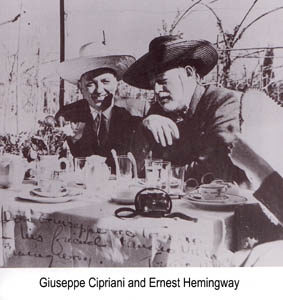 Giuseppe let me know he would be my waiter and I ordered a gin tonic. I skipped the antipasto and proceeded with a first course of cannelloni and then a plate of steak tartare. A bottle of Puiatti Cabernet Franc from Friuli-Venezia Giulia. Crepes alla crema for dessert.
Giuseppe let me know he would be my waiter and I ordered a gin tonic. I skipped the antipasto and proceeded with a first course of cannelloni and then a plate of steak tartare. A bottle of Puiatti Cabernet Franc from Friuli-Venezia Giulia. Crepes alla crema for dessert.
Toward the end of this particular night when I was given the honor of the Hemingway corner, there was a festive group of east coast Americans next to me. I happened to be working. On what I don’t remember, but I was sitting at the Hemingway table with a pen and paper. That was all the guy sitting next to me needed to see.
“Who you supposed to be? Ernest Hemingway?”
First of all, people who know me know that I do my best to be as affable as I can. But I was in no mood for this guy and his unimaginative sense of humor. So I pounded back a swig of my double scotch, looked right at him, and said, “No, I’m not. I’m his grandson – JOE Hemingway. And you’re disturbing me!” I continued to stare at him.
“Gee, I’m sorry, sir.”
At that point, the volume level of conversation throughout the room noticeably declined. I heard a lady a couple of tables over whisper, “He said he’s Hemingway’s grandson or something.” I also have a vague memory of a couple of digital camera flashes going off. Nevio with a calming smile on his face came to my table. “Mr. Cipriani said no more scotch for you.”
Cipriani Goes Forward
The Cipriani organization has always been a family business. Giulietta made key contributions to the business of her husband, Giuseppe, going back to the early years of Harry’s Bar. Giuseppe passed the baton to Arrigo, who was assisted by his wife, Tommasina. Giuseppe put his sister-in-law, Gabriella, in charge of running the Locanda Cipriani. Her charming personality set the tone of the small hotel. In the 1980s, Giuseppe’s daughter, Carla, took over the business. Now her son, Bonifacio Brass, owns and runs the hotel with the help of his wife, Daniela. Arrigo’s children have also been intimately involved with the family business. His daughter, Giovanna, has been involved with the operations of the locations in New York. His other daughter, Carmela, wrote some of his cookbooks. His son, Giuseppe, who lives in New York, is at the helm of Cipriani International and lately has been the main force in expanding the Cipriani enterprises throughout the world. One of his main projects now is preparing the opening of the Cipriani Club Residences at 55 Wall Street, which will be a luxury residential complex.
Monday Lunch
This being my last meal at Harry’s Bar on this trip I was in the mood for a big meal. Once again I found myself at the table in the bar against the wall. Marco, the maitre d’, directed me to the table. I began with a Bellini followed by a negroni. Instead of an antipasto I went for two first courses, the fish soup and then the risotto primavera. My second course was the scampi al thermidor. I saw a Sancerre Rouge on the wine list which I thought would be interesting to try, a red wine but light.
My entertainment for lunch was an apparently well-travel English woman having lunch at a nearby table. She was not having a good lunch experience. She complained and complained. Her soup was too cold, her risotto was too mushy. Dah, dah, dah, dah, dah. I knew she was lying because I had the same things that she ordered. Her waiter tried his best to please her. But the more he tried, the grumpier she became. Marco saw what was going on. At the end of her meal while the waiter ran her credit card, Marco walked up to her table, but did not face her. He stood with his left side facing her table, as if he were occupied with surveying all the tables in the room.
“So lady, what will you do now? Go shopping? Visit the palazzi?” he asked in a tone indicating that he could have cared less.
Her head popped up with surprising sparkle in her eyes. “Oh, no. I think I will go for a walk.”
“That’s a good idea. You have a nice time,” Marco responded without looking at her.
“Thank you very much,” she said. She was now giggly and gave Marco a big smile as she exited Harry’s.
Up until this point, I thought perhaps Marco was applying his experience and skills in the hospitality business to find some way to make this woman leave in a better mood than when she arrived. But now that I think this over, I think that maybe the woman was just crazy.
Departure
I’ve heard that people have walked into Harry’s Bar for the first time without a reservation and told to go outside and come back in again. They are then considered regulars. I got myself a little deeper into it than that. But it’s been worth it. Each time was an experience of flavors and atmosphere to remember. It’s a fun place that I’ll always want to return to. Whatever your preference of frequency at Harry’s Bar, it is a place that everyone should visit if they have the opportunity. Tell them Joe Hemingway said hello.
